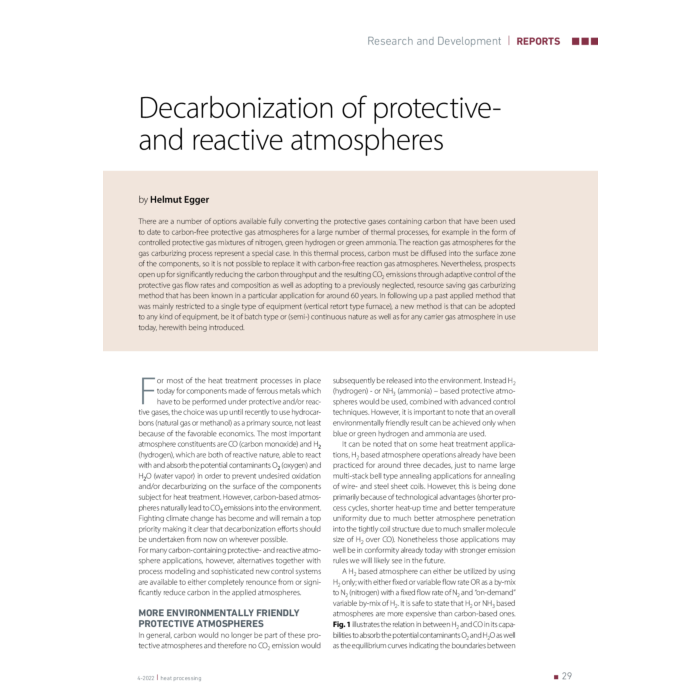Decarbonization of protective- and reactive atmospheres
€4.90
In stock
article number
00541_2022_04_01
There are a number of options available fully converting the protective gases containing carbon that have been used to date to carbon-free protective gas atmospheres for a large number of thermal processes, for example in the form of controlled protective gas mixtures of nitrogen, green hydrogen or green ammonia. The reaction gas atmospheres for the gas carburizing process represent a special case. In this thermal process, carbon must be diffused into the surface zone of the components, so it is not possible to replace it with carbon-free reaction gas atmospheres. Nevertheless, prospects open up for significantly reducing the carbon throughput and the resulting CO2 emissions through adaptive control of the protective gas flow rates and composition as well as adopting to a previously neglected, resource saving gas carburizing method that has been known in a particular application for around 60 years. In following up a past applied method that was mainly restricted to a single type of equipment (vertical retort type furnace), a new method is that can be adopted to any kind of equipment, be it of batch type or (semi-) continuous nature as well as for any carrier gas atmosphere in use today, herewith being introduced.
| Authors | Helmut Egger |
|---|---|
| Publishing Date | 27 Nov 2022 |
| Format | |
| Publisher | Vulkan-Verlag GmbH |
| Language | German |
| Title | Decarbonization of protective- and reactive atmospheres |
| Description | There are a number of options available fully converting the protective gases containing carbon that have been used to date to carbon-free protective gas atmospheres for a large number of thermal processes, for example in the form of controlled protective gas mixtures of nitrogen, green hydrogen or green ammonia. The reaction gas atmospheres for the gas carburizing process represent a special case. In this thermal process, carbon must be diffused into the surface zone of the components, so it is not possible to replace it with carbon-free reaction gas atmospheres. Nevertheless, prospects open up for significantly reducing the carbon throughput and the resulting CO2 emissions through adaptive control of the protective gas flow rates and composition as well as adopting to a previously neglected, resource saving gas carburizing method that has been known in a particular application for around 60 years. In following up a past applied method that was mainly restricted to a single type of equipment (vertical retort type furnace), a new method is that can be adopted to any kind of equipment, be it of batch type or (semi-) continuous nature as well as for any carrier gas atmosphere in use today, herewith being introduced. |
Write Your Own Review

